Update on modern slavery referrals from detention and prisons
Updated 19 July 2021
The Home Office published a research report in March 2021 showing the prevalence of nine ‘issues’ that are raised within immigration detention, such as asylum applications, judicial reviews and referrals of potential victims of modern slavery. This covered people who left detention in 2017, 2018 and 2019.
This new report provides further analysis on referrals of potential victims of modern slavery through the National Referral Mechanism (NRM):
Section 1 shows the prevalence of NRM referrals more recently, showing how referrals from detention have changed in the following 17 months since the initial analysis, up to May 2021. The COVID-19 pandemic resulted in rapid changes in Home Office operations and, as annual statistics would not illustrate the situation accurately, some monthly data is also provided.
Section 2 shows the prevalence of NRM referrals for Foreign National Offenders (FNOs) serving a custodial sentence in prison, as well as foreign nationals held on remand. These referrals were not included in the original publication, which looked only at issues raised by people held in detention under immigration powers. This section also includes an analysis of the nationalities most associated with FNO NRM referrals.
The Single Competent Authority publishes further statistics on referrals for potential victims of modern slavery. This includes breakdowns by nationality and the number of referrals received from different organisations (including each of the immigration-focused parts of the Home Office).
1. Prevalence of NRM referrals in immigration detention
The Home Office analysis published in March 2021 showed that NRM referrals had risen sharply from 2018 to 2019, with the number of referrals from people detained following immigration offences rising from 718 (5% of detentions) to 1,767 (16% of detentions).
Numbers were lower for FNOs in detention, but also rose from 79 (1% of detentions) to 182 (3% of detentions). Numbers reduced slightly in early 2020 as the number of people in detention fell, but then dropped sharply in April 2020 as the UK entered lockdown and relatively few people were detained.
Figure 1: Number of detentions during which an NRM referral was made
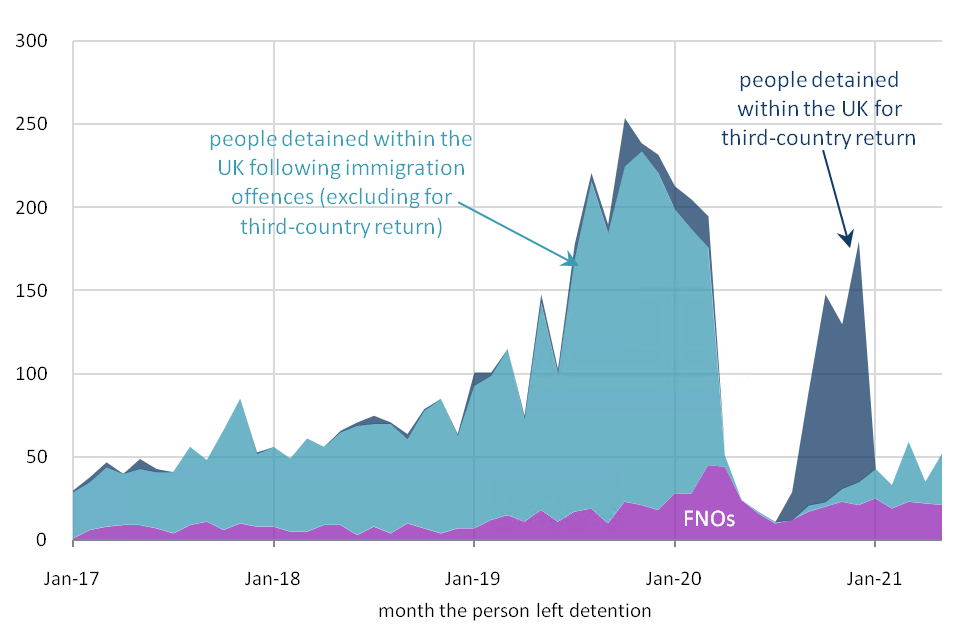
There was a substantial increase in NRM referrals from detention in the second half of 2020 from those being returned to third countries under the Dublin III Regulation[footnote 1]. Between August and December 2020, 849 people were detained for third-country return, of whom 455 (54%) were referred to the NRM while in detention. The Regulation no longer applied in the UK from the end of 2020.
Numbers in 2021 so far remain relatively low compared to 2019, though this is largely due to fewer people being detained due to ongoing COVID-19 impacts. The rate of NRM referrals remains around the high levels seen just prior to the COVID-19 outbreak in the UK – 20% for people detained following immigration offences and 6% for FNOs (averages from January to May 2021).
Figure 2: Proportion of detentions during which an NRM referral was made
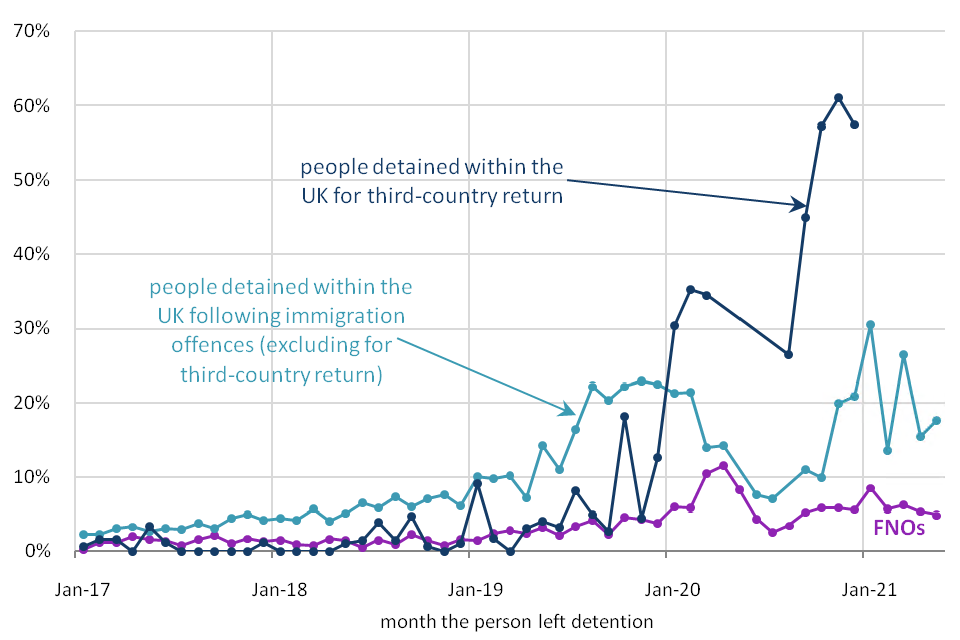
Note: rates are only calculated where there were 10 or more detention exits in the month
Table 1: Numbers of detention exits and those that included an NRM referral
| 2020 | Jan-May 2021 | |
|---|---|---|
| Number of FNOs who left detention | 4,582 | 1,831 |
| of whom, were referred to the NRM while in detention | 288 | 110 |
| Number of detention exits for people detained within the UK following immigration offences (including people detained for third-country return) | 3,746 | 558 |
| of whom, were referred to the NRM while in detention | 1,005 | 112 |
Note: figures for 2017 to 2019 are available in the March 2021 publication
2. Prevalence of NRM referrals among FNOs and foreign nationals held on remand
The original publication looked only at issues raised by people during their time in immigration detention. For FNOs, this is only part of the picture as most people will have served a custodial sentence in the UK beforehand when issues may be raised. Some FNOs will not have been detained at all – for instance, if they were returned directly from prison or bailed immediately on completion of their sentence. This section expands the analysis to look at NRM referrals from FNOs more broadly.
Figure 3: Number of NRM referrals from FNOs and foreign nationals held on remand per month
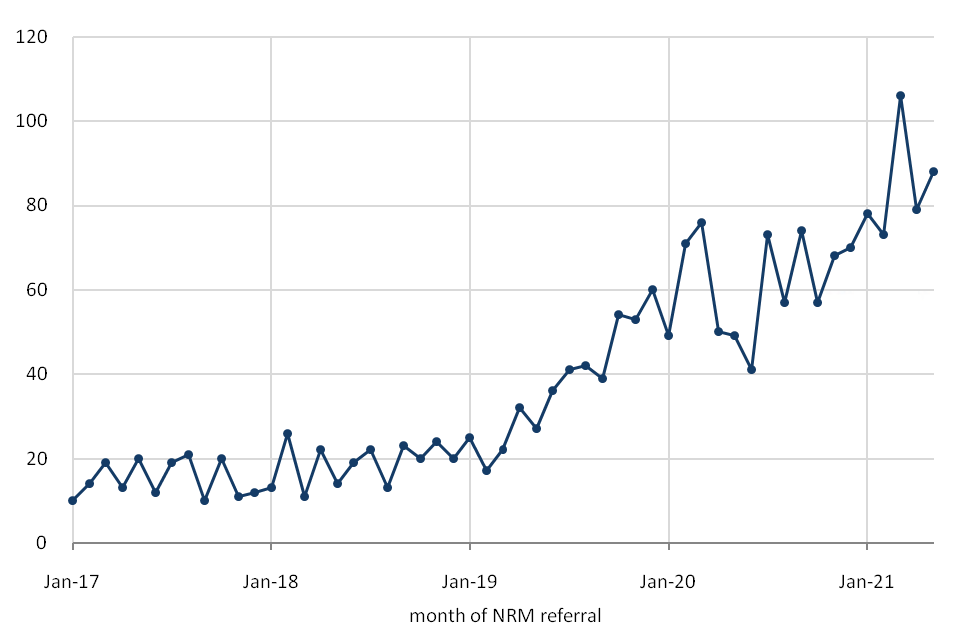
Referrals of FNOs to the NRM (including from foreign nationals held on remand) increased in early 2019 and generally continued to rise since then. Referrals averaged 19 per month in 2018, 37 per month in 2019, 61 per month in 2020, and 85 per month in the first five months of 2021.
However, section 1 showed that FNO referrals from immigration detention dipped in mid-2020 before settling, so clearly the increase must come from elsewhere in the process. Looking in more detail at the referrals, the rise appears to be largely related to people held on remand. Referrals from FNOs in custody are relatively low and stable (50 from January to May 2021). Referrals from FNOs in detention increased prior to the first lockdown in March 2020, but subsequently reduced (as shown in section 1, totalling 130 from January to May 2021). However, referrals from foreign nationals held on remand account for most of the number, and show a clear upward trend (244 from January to May 2021).
Figure 4: Number of NRM referrals from FNOs and foreign nationals held on remand per month, by restriction type
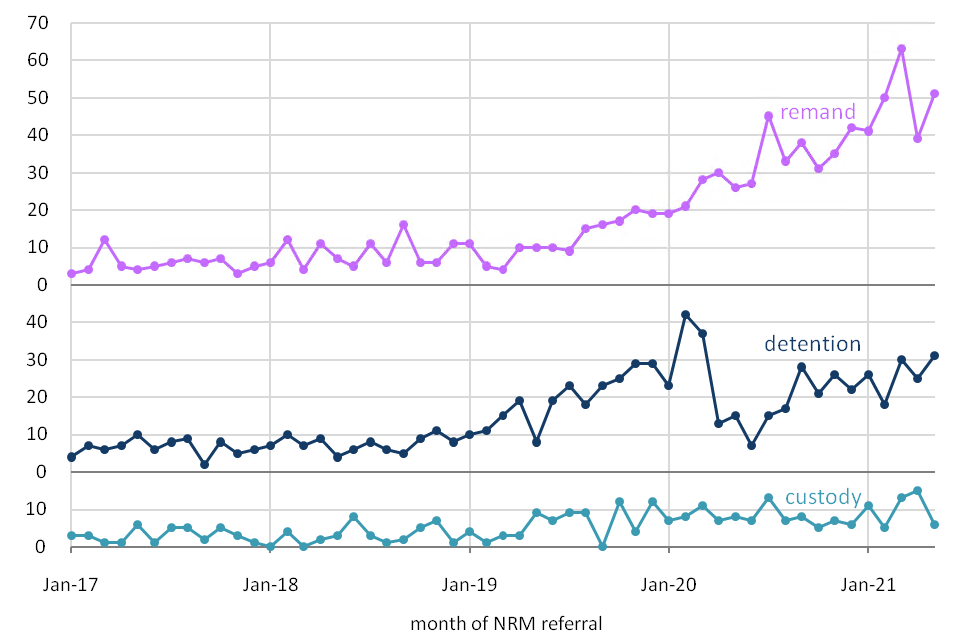
The majority of referrals from FNOs and foreign nationals held on remand have been submitted from Albanian nationals. Looking at referrals between January and May 2021, 63% related to Albanian nationals and a further 18% related to Vietnamese nationals (no other nationality accounted for more than 2%).
Technical note:
Home Office data (from the in-country CID database) records when a person is under a ‘restriction’, such as detention, custody, remand etc., and this is the source for the analysis in section 2. Restriction (and bed occupancy) data on detention is believed to be extremely accurate, and statistics are routinely published using these data. However, data on custody and remand restrictions are not routinely reported and so may be less robust. Ultimately, the Ministry of Justice holds authoritative data on persons in prisons.
Given this potential uncertainty, we also looked at NRM referrals involving anyone with a prior criminal case (so using a completely different part of the Home Office data – cases rather than restrictions). Using this approach shows a very similar picture, with a continued rise in referrals from FNOs and foreign nationals held on remand. The overall level is slightly higher – possibly because the ‘case’ approach will also include referrals from non-detained FNOs, as well as referrals where the person is in prison but has not yet had a custody restriction created on the Home Office database.
Figure 5: Number of NRM referrals from FNOs and foreign nationals held on remand per month, by methodology
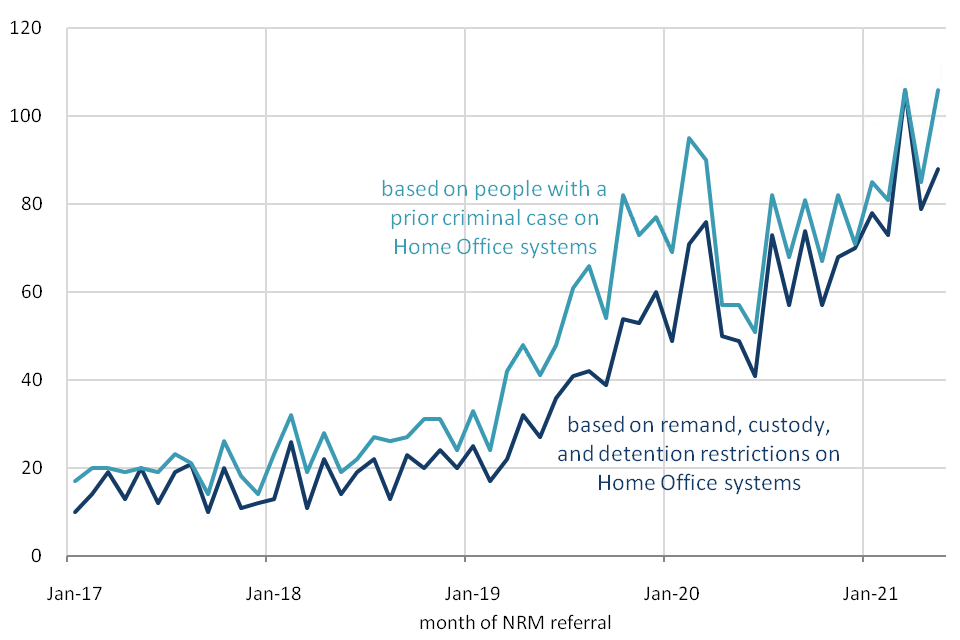
-
The process for transferring asylum claimants into and out of the UK where responsibility for examining an asylum claim lies with the UK or with another EU Member State or Associated State. ↩
